
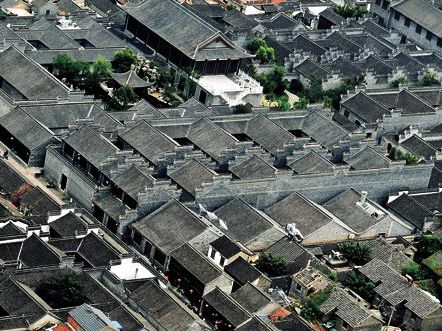
When speaking of the ancient city of Yangzhou, the word refined comes to mind. The 2,500-year-old city in Jiangsu Province is famous for meticulously prepared cuisine, exquisite gardens and a cultivated and slow pace of life.
It was once an ostentatiously wealthy, famous for its brothels patronized by wealthy salt and grain traders and scholars. Famous high-end brothels with fine food and entertainment lined the shores of Slender West Lake. Standing on balconies, courtesans waved their handkerchiefs to pleasure boats that tied up on the docks.
Yangzhou, where the first section of the Grand Canal was dug around 486 BC, use to be a garrison town, but it blossomed and became a trading center and hub for the exchange of all kinds of ideas from around China and the world. A section of canal, lined with beautifully preserved traditional buildings, is a major attraction, largely because it is unspoiled and has not been turned into a gaudy tourist attraction.
Over the years, Yangzhou has nurtured and inspired countless scholars, artists, writers and poets. Emperors traveled by canal all the way from Beijing, then the capital, to appreciate the beauty of Yangzhou and the finer things in life that it offered.
The city flourished in the Tang (618-907 AD) and Song (960-1279) dynasties but the remnants of fortified city walls stand witnessed to conflict as well, as cities in southern China fought the Manchu invaders from the north.
Wealthy salt traders built magnificent mansion in Yangzhou and were able to enjoy the finest in Chinese culture. The city developed its own culture of traditional opera, music, painting, landscape gardening (spectacular gardens were built), and delicate cuisine.
Yangzhou welcomed some 4.47 million visitors during the National Day holiday, up 22 percent from the same period last year, according to its tourism bureau's website.
To improve the experiences of backpackers and other visitors, a bike rental system and 30 travel information counters will be established in downtown areas, said Wang Minghong, vice director of the Yangzhou Tourism Bureau.
A tour guide mobile application in Chinese named "Intoxicating in Yangzhou" is now available for both iOS and Android devices. An English version is expected in the near future.
"We're still working on the app and hopefully it can provide handy information and introductions to scenic spots such as Slender West Lake and the private gardens, which have Wifi," Wang said.
Spring is the best time to visit Yangzhou "in the mists and flowers of spring," described by the poet Li Bai (701-762 AD). That's when clouds of blooming viburnum fill the air.
Still, the city (the old city, that is) has much to offer all year round.
Day 1 Slender West lake & Daming Temple
11am
Yangzhou is renowned for Huaiyang (huai for the adjacent Huai'an City and yang for Yangzhou) cuisine of southern China. One of China's eight most influential cuisines, it is often served at state banquet in Beijing. It is light and meticulously prepared with elaborate cutting, dicing, slicing and shaping of ingredients — the dimensions must be exact. The ingredients from the fertile river lands are always fresh. Chefs pride themselves on their soups that simmer for hours.
The Yiyuan Restaurant near Siwang Pavilion serves a wide range of typical Huiyang dishes, such as steamed pork balls with crab paste, steamed dried bean curd slices, carp head soup and marinated goose. A bowl of delicious not-too-oily Yangzhou fried rice is a must. Signature dishes of Shi Wei Tian Restaurant (785 Yangzijiang Rd M.) include the spicy and numb goose feet and fried eel with soy sauce.
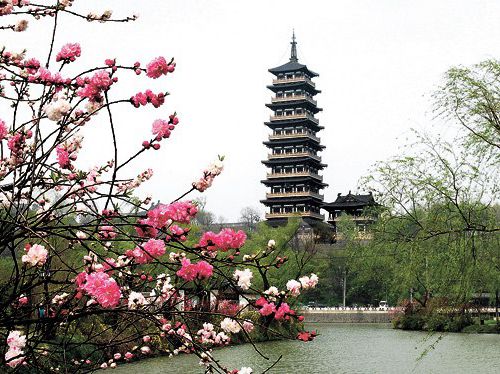
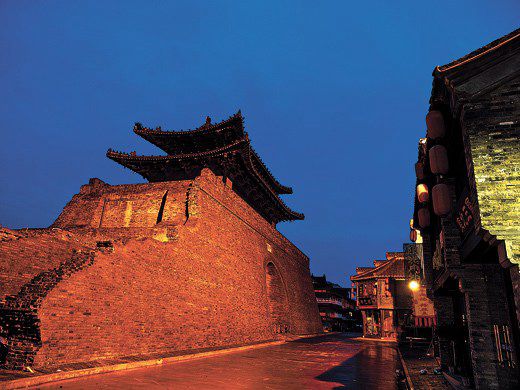
1pm
A walk along picturesque Slender (shou) West Lake will aid digestion. There are also boat rides. The word (瘦, shou) not only refers to its slenderness — the widest section is no more than 100 meters — but the delicate scenery along the way. The lake's beauty was endorsed by Emperor Kangxi and Qianlong of Qing Dynasty (1644-1911) who each made six visits here.
Exquisite private gardens built by wealthy owners once dotted along the lake in its prime time. Some of them still remain. Views are varied, including weeping willows along the footpath, the 15-arch Wuting Bridge, and the White Pagoda, said to have been built overnight by a tycoon. It also has one of the most artistic Diaoyutai, or fishing pavilions in China. Standing on the right corner in front of the pavilion built on an islet amid the lake, visitors can see Wuting Bridge reflected in the water from one arch, and the white pagoda reflected in another.
3pm
Leave Slender West Lake through the north gate, and head west to Daming Temple. Built during AD 457-464 of the Southern Dynasties, the temple was one of the few relics to survive the "cultural revolution" (1966-76), when many temples, pagodas, sculptures, paintings and calligraphy were burn, smashed and destroyed — because they represented religion and feudalism.
It was renamed in Qing Dynasty (1644-1911), since any mention of "Ming" (Daming) was considered taboo. Yangzhou people refused to use the new name, instead referring to it as Pingshan Hall. It is built behind the temple of the famous magistrate and scholar Ouyang Xiu (1007-1072) as a place to view the lake, gather with scholar friends, drink and write poetry.
This is a good place to rest, enjoy the view that inspired the writer and admire his calligraphy.
4:30pm
The awe-inspiring mausoleum of Guangling Lord Liu Xu (died in AD 45) was first excavated 45 kilometers from Yangzhou, but relocated because of underground water leaks. The elaborate tomb is a magnificent example of "huangchang ticou," a burial style reserved for royal families in the Western Han Dynasty (202 BC-AD 9). It is built with mortise and tenon joints. There are 856 rectangular columns of rare gold phoebe wood with a camphor scent. It has no roof but contains dozens of rooms and bathroom. The scent of gold phoebe fills the premises.
The tomb of the lord's lady is a bit smaller and simpler, but it too was built elaborately of gold phoebe. No wonder the royals of the Eastern Han Dynasty (AD 25-220) opted for stone to build their tombs. There was not enough gold phoebe wood.
6pm
Explore the Siwangting Road and Huaihai Road for dinner options. Lined with restaurants and eateries, it has a lot to offer. Visitors can choose among authentic Huaiyang cuisine and local snacks, hot and spicy Hubei food, sour and spicy Guizhou rice noodles, hot pot, or even Western steak.
8pm
It's time to enjoy a soothing nationally famous Yangzhou-style pedicure. The city names three important professions by their tools: kitchen knife, razor and pedicure blade, meaning chef, barber and pedicurist. Yangzhou pedicurists not only trim and polish toenails, but also remove thick callouses, corns and dry skin. They also treat skin conditions including various foot and nail fungus. These treatments are described as "carving on the foot."
A skilled Yangzhou pedicurist is said to be able to cut a soy bean into chips with a pedicure blade without holding the bean in the hand.
The shop run by master pedicurist Zhu Qinghua near Nanhexia Street is a local favorite. A foot bath and massage costs 45 (US$7.40) to 55 yuan. A pedicure to remove rough skin costs 20 yuan. Alternatives include the Lu Qin's Pedicure chain run by female pedicurist Lu Qin, and some public bath centers.
9:30pm
Take a walk along the ancient Grand Canal in the soft night breeze. The section is well preserved and attractively lighted. For more than 2,500 years, the canal witnessed the city's triumphs and setbacks. Along the bank (Taizhou Road), the city has done a lot of renovation since China plans to seek UNESCO World Heritage status for the entire canal system, not just the Beijing-Hangzhou-Yangzhou section that is best known. The ancient town area of Dongguan Street is bustling. Middle-aged people dance in nearby plazas. Head down to Nantong Road E. for drink. The city doesn't have Shanghai's or Beijing's dazzling night life, but it does have nice bars along 1912 Street, with live music and, if you're lucky, a view of the canal.
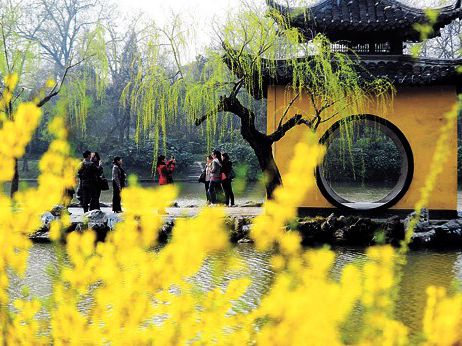
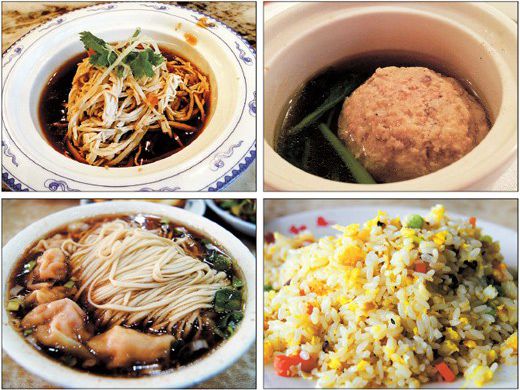
Day 2 Old town
7am
Breakfast is a chance to taste meticulously prepared Huaiyang cuisine. Yangzhou is famous for its breakfasts, originally developed for wealthy salt tycoons in the Ming (1368-1644) and Qing (1644-1911) dynasties.
A typical Yangzhou breakfast starts with appetizers, such as jelly salted pork slices, marinated ginger slices, and sliced dried bean curd. Then comes a bewildering array of snacks. Try sanding bao (steamed buns filled with chicken, pork and bamboo shoots) and feicui shaomai (unsealed emerald-green dumplings filled with vegetables and pork) at Fu Chun Tea House. Huangqiao shaobing (crispy crusted pastry with white sesame, either sweet or salty) and shrimp noodles are among the signature snacks of Yechun Tea House. Be careful with xiehuang tangbao (steamed bun filled with crab paste), in case the hot soup spills out. Wash down breakfast with a cup of fragrant green tea.
It's pleasant to enjoy a special breakfast in the tranquil dining hall of Lu's (Lu Shaoxu), a salt tycoon during the Qing Dynasty. His residence is now a restaurant furnished with old-fashioned square tables and antique furniture. Visitors can explore the rest of the house for free after breakfast. Otherwise, admission is 20 yuan.
8am
Set out on a tour of private gardens and former residences of wealthy salt traders. Compared with the private gardens in Suzhou, those in Yangzhou are larger, showier and more lavishly decorated. Merchants liked to display their wealth, in contrast with the simpler classical gardens of Suzhou and the imperial gardens in the north.
Magistrate Wu Yinsun's Residence is the largest and most spectacular Zhengjiang-style residential complex in Jiangsu Province. Locals call it "Ninety-nine and a half rooms," second only to royal residences and palaces, since nonroyals were not allowed to build a house of more than 100 rooms.
From the outside, there are tiers of "horse head" shaped fire walls and upturned flying eaves. Among five rows of spacious ancient Chinese-style rooms is a two-story red brick Gothic building. Built to meeting foreign businessmen, the building was quite "fashion" at that time, with its Roman pillars, arched doorways and wrought iron fireplaces.
A 1,500-meter two-story corridor winds around in He Zhidao's garden, or Heyuan Garden. A pond lies in the center and above it builts a pavilion where the family could enjoy the garden and the breeze, and watch traditional operas. It's quite advanced in design, since the water and corridors enhance the sound.
The French-style shutters, fireplace and ironworks add a Western flavor to Yuxiu Building, the main two-story building where live generations of He's masters.
Bamboo is a highlight in Geyuan Garden. The character ge (个) is a half of bamboo (竹). A bamboo-lined trail leads to the main garden where the owner elaborately landscaped four distinctive sites to represent the four seasons.
If time permits, visitors can explore the old town around He's Garden to see modern private gardens. Influenced by their ancestors, some locals create their own interesting rear gardens. Knock on the door and, hopefully, the owners will invite you for tea and show you their garden.
12pm
Food stalls, eateries and restaurants are jammed along old-fashioned Dongguan Street. Visitors can try a range of local delicacies, including shaobing (crispy crust pastry), beef soup and beef dumplings, glutinous dumplings with four different fillings, and noodles with deep-fried smoked fish in soy sauce soup.
2pm
Stroll down Dongguan street and explore the nearby maze of narrow streets. Centered around Dongguan Street, the area represents a typical "fish bone" design of street and radiating lanes. It's said there's a story behind every street and lane name. Wandering around, visitors may think they have reached a dead end, when they find a lane leading to a new pathway.
Here visitors can buy last-minute gifts, such as cosmetics packed in old-fashioned style from Xie Fu Chun, a centuries-old brand in Yangzhou.
How to get there:
A long-distance coach to Yangzhou departs daily from the Shanghai Long Distance Bus Station between 7am-7pm. It takes around five hours to get there and costs 93 yuan. It saves time to take high-speed or bullet trains from Shanghai to Zhenjiang, then take a bus to Yangzhou. That train and bus trip takes around two hours. Trains operate between Shanghai and Zhenjiang every day from 6:30am to 9:15pm. There are frequent coaches running between Zhenjiang and Yangzhou.
|
|
||
 |
| Touched | Sympathetic | Bored | Angry | Amused | Sad | Happy | No comment |
Rhythm Media Group is a multi-media company, operating a US-based Chinese daily newspaper, The China Press, and the paper's website - uschinapress.com (which has mobile-app version), as well as a Beijing-based English website Sino-US.com. The group boasts 15 branch offices across the US, and a number of cultural centers focusing on culture-related business in the North America, Chinese mainland, Hong Kong and Taiwan.Launched in September 2012, the Sino-US.com is designed to serve as a bridge between China and the US, and to keep its readership inside or outside China better informed by providing news and insights on China's current affairs, culture, life, business, people and sports.
|
|